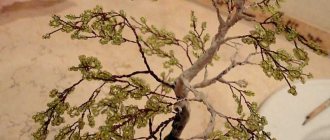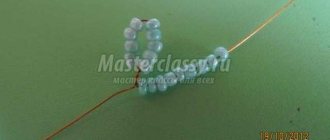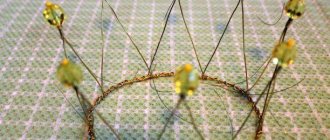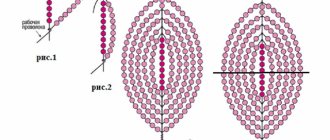Preparing for weaving
It would be interesting to try to make a cactus from beads in a master class using two techniques: parallel and French. This is the simplest version of the craft, however, it looks interesting and decorative. In addition, using two weaving techniques in one product will improve practical skills, and weaving patterns can be used in the manufacture of other crafts. For creativity you will need :
- beads (green, white, yellow);
- wire (0.3 mm - working and 0.5 mm - warp wire using the French weaving technique);
- ready-made base mold in the shape of a cactus or polystyrene foam;
- paint or tape;
- small flower pot;
- mixture for preparing plaster;
- universal glue.
Step-by-step weaving and assembly techniques for beginners
After preparing all the materials, you can begin the beaded cactus master class with step-by-step photos.
Making the base
To know how to make a cactus from beads, you need to decide on its appearance. Now we will show a diagram of a very original and simple plant.
For the base, take two pieces of foam, connect them together and make a rounded cactus shape. Paint it green and leave to dry.
Decoration of thorns
The spines in our cactus will be very unique. Let's create petals using the French technique:
- add 5 beads to the wire in the middle;
- twist one end completely;
- twist the other end, but leave it free;
- beads are strung on the free end;
- count 8 pieces and bend the wire;
- fasten to the last bead on the base;
- there should be an arc;
- also count out the same amount of beads and bend the wire down;
- make 13 similar arcs, the last ones from light beads;
- create 23 leaves of different sizes.
Photo source: https://vnitkah.ru/wp-content/uploads/kaktus_iz_bisera_43.jpg
Weaving a flower
A beaded cactus flower is the most beautiful element of the craft. It will become the accent of the entire plant, so it’s worth trying and doing it carefully. Beaded cactus flowers are created using the same pattern as the leaves we described above. Use pink beads or any other you like. The flower will need 18 petals. Some petals can be made with an ombre effect.
Photo source: https://vnitkah.ru/wp-content/uploads/shema_lepestkov_dlya_cvetka_kaktusa.jpg
Pestle in parallel technique
The pestle is created using a parallel stitch. You will need 3 pestles, which consist of 7 rows. Twist the pieces of wire and add light green beads to them. Twist all the pieces to form a stem.
Working out the stamens
To make stamens you need:
- collect light green beads onto the pieces;
- add 3 yellow beads to the ends of the wire;
- make a loop of yellow beads;
- pass the long end of the wire through the green beads in the opposite direction;
- make 17-20 such stamens.
Assembly of all elements
This is the most crucial moment. Assemble the cactus as follows:
- using a stiff wire, attach the leaves in a checkerboard pattern around the base;
- fill the entire base;
- make a hole in the base for the flower stem;
- place the flower in the flowerpot.
We see a beaded cactus in the photo.
Photo source: https://vnitkah.ru/wp-content/uploads/cvetok_dlya_kaktusa_iz_bisera_18.jpg
Photo source: https://vnitkah.ru/wp-content/uploads/kaktus_iz_bisera_62.jpg
Creating spines
The thorns are made very simply: even a child can handle them. To do this, several dozen green beads need to be strung on a wire. To make one spine, separate eight beads per edge. Using the free end of the wire, you need to make a loop by threading it through four beads. The wire should be cut so that there is a tail of 3 cm on one side and 1 cm on the other.
First, let's make a large sepal:
- Cut a piece of green wire 40 cm long.
- Step back 7 cm from one of the edges of the wire and make a wire loop, as in the photo. These are the base of the sepals that make up the entire beaded cactus, including the flower.
- Place 5 pieces of dark green beads on the short edge of the wire, and 7 pieces of the same color on the second edge.
- Secure the long edge of the wire over the beads onto the short base.
- Now put 7 more pieces of the same beads on the wire, and fix the edge of the wire on a short base under the beads.
We continue weaving the leafThus we weave in a circle. One circle consists of two arches. This weaving pattern is called French weaving, and it is exactly what is needed to create a cactus from beads.
- The second circle consists of 11 pieces of dark green beads on each of the arms.
- Each arch of the third circle consists of 15-17 pieces of beads (depending on the size of the beads and the tension of the wire).
- Each arch of the fourth circle should have 24-25 pieces of dark green beads.
We continue weaving - The last fifth circle consists of pale green beads.
There should be 28-30 beads on one bow. Wrap the edge of the wire completely under the beads. Do not hide the excess edge of the top wire; it will act as a plant needle. The last fifth circle is made of pale green beads - Now you need to be patient and make a lot of these sepals. Their number depends on the desired size of the future cactus. You need to make at least 30 of these leaves.
Next you need to make small sepals. They need to be woven exactly like the previous ones, only you need to put 4 pieces of dark green beads on the central base, and the entire leaf will consist of only four circles (8 arches).
Making the base
Art and craft stores sell ready-made forms - the basics. If there is no suitable one, you can make it yourself from polystyrene foam, giving it the desired shape using a knife. The base should be painted green or wrapped tightly with green tape. Pour plaster into a flower pot and mark the future cactus in the center. Mask the edges with pebbles or large multi-colored beads.
Stick the spines tightly into the prepared base and fill the entire surface of the future cactus with them. For a more durable attachment, lubricate the base of the spines with glue.
Complementing with beauty
For the flower you need:
- Orange beads No. 10 and No. 15;
- Yellow and light yellow No. 10;
- White and transparent No. 10;
- Gold beads No. 10;
- The oval-shaped bead is light green;
- 5 yellow beads 3 mm with edges.
Article on the topic: Knitting raglan for children using the example of a blouse for a child under one year old: diagram and description
There should be two types of stamens, five each; string beads onto a 35 cm piece of wire in the following order: 5 yellow-light green, light yellow and matte white, one golden. Then you need to return the wire through all the beads except the gold one. Make 4 more stamens in the same way. The other 5 stamens are woven in exactly the same way, but only seven each. beads, and the last one is not golden, but a bead measuring 3 mm. Large stamens need to be inserted into an oval-shaped light green bead.
Collect this way: you need to screw a 2 mm wire to the large stamens, then distribute the stamens around them, then the small petals, then the medium and largest ones. After this, tightly rewind this stem with green threads and fasten it with glue. Insert into the cactus and you're done!
Insert the glass into the flower pot, you can decorate your home.
Formation of a flower
A flower consists of petals, stamens and pistil. Petals are woven using French technique
The French beading technique is based on the use of a warp wire and a working wire braided around it. This way you can weave elements of different sizes in a round or oval shape.
The size of the petal depends on the number of beads in the initial row. In order for the flower to turn out lush and beautiful, you need to make petals of different sizes :
- Petals with a base of 20 beads and nine rows of weaving will be the most voluminous main petals of the flower. You will need about six of them.
- If you braid a base of 30 beads in 11 rows, you will get longer and elongated petals. You need to make 4 of these things.
- And the narrowest petals will be obtained when weaving with a base of 30 beads and nine rows. The latter can be combined from beads of different colors.
Cactus with fluffy spines made of beads
This master class will show you a simple way to weave and decorate a cactus, which, when completed, looks like a real one. And it’s not immediately clear that the flower is made of beads.
The first step is to make the base of the craft. To do this, you will need round foam plastic, which can be easily purchased at a specialized craft store. If there is no exactly a round shape, then form it yourself from a piece of polystyrene foam using a knife. You will then insert the formed blanks into this ball.
After this we move on to weaving the thorns. Take a wire and string ten beads onto it. Then you need to close the product into a ring. The second ring of the same type needs to be passed through five pieces of glass and tightened. The result should be an oval like this. One edge of the base material should be 1 centimeter long, and the other four. Make two more of these elements with your own hands and twist them. The first thorn is ready. You will need a large number of such blanks to make the cactus as magnificent as possible.
Then we move on to weaving the flower. Take a small piece of wire and prepare yellow beads. The product will consist of loops, which then need to be assembled together. Their size can vary from small to larger. Basically, a large bloom should have about twenty loops, and a small one about twelve. In the photo you can see how the loop is formed.
Read
We learn to weave a blooming Decembrist from beads using master classes for beginners
Even a child can repeat such simple weaving steps. So don't delay, get to work immediately! And may everything work out for you!
We are studying the second method of weaving a flower in a small MK
In this master class we will look at how to weave a more complex cactus. The weaving technique of this cactus differs from the previous one, and it itself is unlike the cactus from the previous version. We will need the following materials and tools:
- Copper wire 1 mm.
- Green beads.
- Wire cutters.
Let's cut three pieces of wire. One of them should be 16 centimeters, and the other two are slightly shorter (about 12-13 centimeters). To better master the techniques of making this cactus, you need to know its shape. You can consider the image of any multifaceted cactus. This way we can understand what this plant looks like. This multi-faceted cactus will look good in any home or office interior. Let's start weaving by determining the middle of each prepared wire and folding it together, connecting them in the middle. Next, you need to twist these wires using a separate piece. Next, we will separate the wires, creating six separate rays, united with a common middle. We collect green beads on a 0.3 mm wire, measuring two meters and 40 centimeters in length. We begin to braid alternately with thread and beads all the individual wires in a circle. We draw the wire so as to cover the middle, where all the rays of the wire come from. Moving our knitting along a circular line, we determine in each case what size of beads to leave in a certain interval.
This circular weaving must be continued until we reach the edge of the short wire, leaving ends 0.5 centimeters long free. The further we move from the middle to the end of the weaving, the more beads we place in the spaces between the rays of the wire. In the event that you do not have enough wire with pre-strung beads, we do not need to despair. We attach the remaining tail of the wire to one of the rays, and continue working with the second piece of beads.
This weaving technique allows us to create a round part of our plant. We will need five of these parts. The best number of rows of beads from the middle to the end of the leaf is 15 or 16 rows. The fact is that very large parts will be quite difficult for us to combine together. Therefore, when we have created all five parts, we continue to braid our beaded cactus, which consists of five lobes. Finishing work on each individual detail, we will make the last row of white transparent beads. This is necessary to give the details completeness.
Once all our parts are created, we will need to tie everything together. First, let's bend each of the parts at an angle of ninety degrees, then we need to combine all the parts into one product. As a result of such a combination, one monolithic product will be produced. It has the shape of a five-pointed star in horizontal section. The merging process begins by placing two leaves next to each other. The edges of these leaves must converge, otherwise the alignment will be incorrect.
Let's take a wire of medium thickness and match the ends of the parts in several places. We will make a combination where the parts of the circles are adjacent to each other. If the circular arcs of the parts do not fit perfectly, then you need to grab onto one of the parts and attach the wire to the other part where it is more favorable. The most successful combination is at the bottom, middle and top of the parts. We do not cut the wires that twisted our parts to the end. It is necessary to leave about five millimeters in order to imitate the spines of the plant. After the five parts have been combined into one, we will weave all the wires at the bottom of our product, creating the stem that will be placed in the pot.
Since the cactus is empty from the inside, we will hide this emptiness with the help of a large cactus flower located on top. To create it we will need the following materials: yellow, orange, white beads, beige thread, wire cutters or scissors, 0.3 mm wire.











